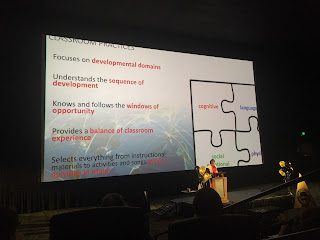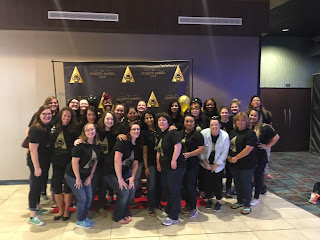Best of Parenting 2023

Aug 31, 2018
Fall Conference 2018
Today the Academy of Cool Springs attended our 2018 Fall Conference. Our educators had training on The Power of Early Educators, Intentional Teaching, and Conscious Discipline. Two of our teachers, Ms. Rachel and Ms. Keisha, were voted our all stars this year, and we were recognized as receiving the highest STARS scores this year and the highest in the entire company's history!
Aug 30, 2018
Under the Sea with Ariel
This afternoon, our students had a special visitor during enrichment time. Ariel from The Little Mermaid came to visit. She shared stories and songs with our classes.
Aug 23, 2018
Shape Scavenger Hunt
Our Pre-K Two class explored our playground with a shape scavenger hunt. Everyone looked for various shapes and pointed them out.



Our tunnel is a circle!
Our Lego blocks are squares!
The bubble wand is a circle!

Our dramatic play mirror is a rectangle!
We found two cone shapes!
Aug 14, 2018
Playdough Fun!
Our Pre-K Two class had fun making homemade playdough! See below benefits of playdough play and the recipe to make your own at home!
1. Fine Motor Skill Development: great for strengthening muscle tone in little hands – squishing, squashing, rolling, flattening play dough all develop children’s muscles and encourage prewriting and other skills such as cutting with a scissors, using a tweezers, holding a pencil etc.
2. Calming and therapeutic: simply sitting and squashing and rolling a piece of playdough in your hand is a very calming and soothing activity. For years I have been giving children playdough “stress” balls in class as a way of easing tension, releasing extra energy, improving focus and concentration. Can be a great outlet for children to express their emotions
3. Creativity and imagination: the possibilities for playdough play are limitless – my kids love to create all sorts of things with playdough – some days they create monsters and aliens, on other occasions they have made cupcakes, pizzas, gardens, houses, Christmas decorations. I love to provide them with a wide variety of materials to use with the playdough, inspiring creativity and encouraging use of their imaginations.
4. Develops hand-eye co-ordination: by using a variety of materials and objects in playdough play can enhance hand-eye co-ordination.
5. Social skills: any activity where children are hands-on involved creates a fantastic opportunity for developing social skills. Playing with play dough in small groups and or with adults presents lots of possibilities for talk and discussion, playing collaboratively, problem solving and planning with others. Encourage your children to describe what they are doing while they play.
6. Literacy and Numeracy development: we have used playdough for a variety of literacy and numeracy activities – it’s a great fun way of involving children in literacy and numeracy activities, some of which you can see in our Prewriting Activities.
7. Promotes Play: allows children to be children, to slow down and play, using a range of their senses and skills.
Ingredients
- 2 tbs cooking oil
- 4 tbs Cream of Tartar
- 2 cups plain flour
- 1 cup salt
- Food coloring
- 2 cups water
Mix all the ingredients in a saucepan and stir over medium heat for 3-5 minutes, until the mixture congeals into playdough.
Aug 8, 2018
It's a Balancing Act!
Balance is a fundamental skill necessary for maintaining controlled positions, such as sitting in a chair, or engaging in physical activities like running or riding a bike. Having balance makes motor skill development easier, reduces the risk of injury, and helps children focus on academic tasks.
Here are some ways we help improve balance in the classroom, as well as ideas for you and your child to do at home.
INFANTS:
- In the classroom: Tummy time promotes neck, back and abdominal strength needed for infants to eventually push up, roll over, sit up and crawl. Teachers keep infants engaged by using activity mats or plush blocks.
- At home: Place your baby on his stomach and shine a flashlight near him. Once you have captured his attention, shine the light in a rhythmic pattern. For older infants, encourage your baby to move or crawl toward the light.
TODDLERS (ages 1-2):
- In the classroom: During the toddler years, children make major strides in balance and coordination. Teachers play music and encourage students to move their bodies in different ways while maintaining their balance.
- At home: Push and pull toys require children to use core balance and arm strength, which can be difficult for new walkers. Place a small wagon or toy shopping cart and a pile of blocks on the floor. Show your child how to fill the cart with blocks. He will enjoy pulling or pushing the blocks around the room.
BEGINNERS (ages 2-3):
- In the classroom: Sitting cross-legged, or as we say with the children “criss-cross applesauce,” is an important developmental skill for two year olds. Teachers encourage children to sit criss-crossed anytime they are playing on the floor. Sitting in this position strengthens a child’s core muscles and helps improve body control. We discourage “W-sitting,” with knees together and feet on either side of the hips, because it puts strain on knees and hips and fails to engage core abdominal muscles.
- At home: Provide your child with a sit-and-spin toy. Ask him to sit on the toy with his legs crisscrossed. As he turns the wheel to spin, he will gain a better understanding of cause and effect.
INTERMEDIATES (ages 3-4):
- In the classroom: Around age three, children learn to maintain control of their upper body while moving their lower body. Our Intermediate students practice pedaling a tricycle, bouncing on hopper balls, and walking on a balance beam.
- At home: Have your child practice running and stopping with control by playing the traffic light game. Shout out the color green, yellow or red. Have him move quickly when hearing “green,” move slowly when hearing “yellow,” and completely stop when hearing “red.”
PRE-K/PRE-K 2 (ages 4-5):
In the classroom: Teachers encourage children to practice balance and coordination by jumping on their non-dominant foot, walking on a line or beam, or jumping rope. Children also practice balance by crouching down to tie their shoes.
At home: Ask your child to tell you about the games and activities played at school. Include these activities at home and during family events such as birthday parties and vacations. Scooters and pogo jumpers are great toys for children at this age.
See how our Pre-K students learned all about balancing and worked on their balancing skills!
Subscribe to:
Posts (Atom)






























